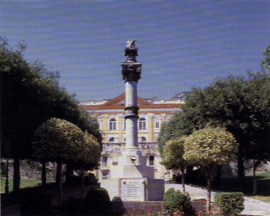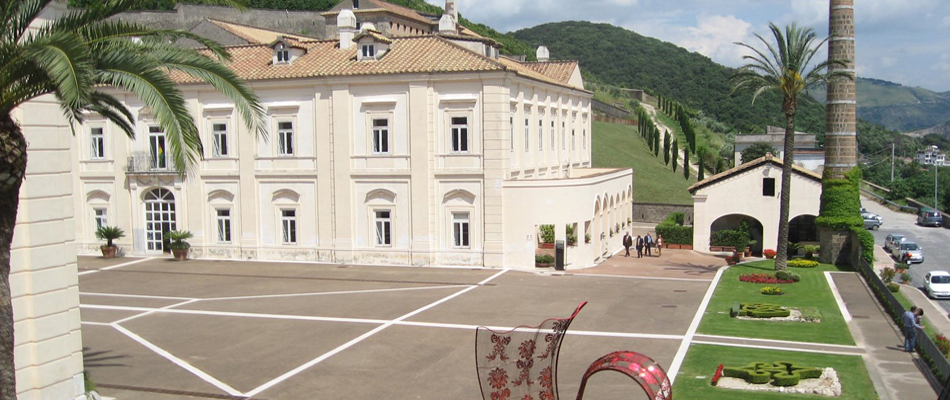The Royal Site of San Leucio
The Royal Site of San Leucio is something more than one of the many “Bourbon sites”: it represented a revolutionary socio-economic institution.

Its area was chosen by Ferdinand IV in the ‘60s after the completion of the work at the Royal Palace of Caserta. In those years, the young king took the habit of residing more often in Caserta, whose surrounding areas were an ideal location for his favourite sport, hunting.
The Sovereign himself wrote a volume on this matter, whose title was Origine della popolazione di San Leucio (Origin of San Leucio’s Population), printed in 1789, in which we read: «In the magnificent palace of Caserta, whose construction was begun by my august father and continued by me, I did not find silence and solitude to meditate and rest my spirit; but another city in the middle of the countryside, with the same luxury and magnificence of the capital; and therefore, to find a more secluded place, almost a retreat, I thought of San Leucio’s hill. Hence the origin of this colony».
Once chosen San Leucio’s reserve, in 1773 he decided to build a lodge, later called “Vaccheria”, destined to rest during the hunting. A tragic event took place in this house in 1778: the Crown Prince Charles Titus died there.

Since then the two Sovereigns, overcome with grief, did not want to reside there any more; however, the King decided to use it for other purposes, to draw some useful advantage from it.
Very close to the “Vaccheria” there was the only baronial lodge of the Acquaviva family. Ferdinand had a brilliant idea: he tasked architect Francesco Collecini, one of Vanvitelli’s students, to widen and transform the Belvedere construction into a royal silk mill with the aim of building around it a large site of textile spinning mills, a real “industrial city”, to populate with workers and to be ruled by special laws, regulations and life practices.
The first silk mills were located in the same structure; then in 1805 the “Filanda dei Cipressi” was built and enlarged in 1823 by the realization of a superstructure called “coccolliera” (cocoon warehouse) to store the cocoons obtained by silkworms.
The houses of the mill manager and the parish priest were located inside the structure, as well as a school, rooms where to spin and wring the silk and dye it, the house of the school mistress and that of the machinery supervisor. The royal apartment was located at the upper floor, in direct contact, through a corridor, with the loom room.

There were also other rooms for dancing and dining; the Queen’s bathroom was very peculiar: designed as an ancient thermal bath with a large “calidarium” bathtub in an oval shape made of stone from Mondragone and embedded into the floor and filled with hot water through a stove located in the room below, it had walls decorated with frescoes by Philip Hackert [This information is quoted from “Il Real Sito di San Leucio”, by R.M SELVAGGI, in “Album di famiglia. L’iconografia borbonica”, Associazione Culturale Campania 2000, Arti Grafiche Sud, Napoli, pp. 9-15].
The King populated this site with workers for the silk mills and built a real “city-state”, with precise regulations and practices of its own.
In his book, Ferdinand IV explains his worries about the education of the workers’ children, the support of their family and a peaceful work situation, so that each man and woman could get one’s living from his or her work and never be idle, since the Devil does work for idle hands.

To this end, he would establish rules for the living and working together that made the site of San Leucio famous all around the world as one of the first attempts of Enlightenment-like rural socialism which was also a utopia, although the king’s intentions were supported by a sound royal paternalism. In fact, the King wrote: «(…) the rules and laws to be obeyed by San Leucio’s inhabitants, who from now on must think of themselves as belonging to a single family, are those that I now propose and write, more as instructions given by a Father to his children than as laws written by a legislator for his subjects» [In: ibidem, p. 14].
The provisions were many and ruled also aspects of private life:
- equality: «no one must think of himself/herself as superior to others, if not for his/her model behaviour and excellent work;
- marriages: men were to be over 20 and women over 16, and, most of all, «parents had not to influence their choice, but the young people had to choose by their own free will»; the dowry was abolished, and the sovereign himself provided a dowry to the couple;
- «The aim of this society is that all remain to live in this place»: the laws for those who wanted to marry elsewhere were very strict: that person had to leave the colony forever; for those men who married external women who desired to live in San Leucio, these women had to learn their job first and then could come and live there;
- education: compulsory for everybody, «so that each one could become a good citizen and an honest person»;
- remuneration: according to the expertise of each worker, up to a maximum «granted to the best national and foreign artists»;
- inheritance: testaments were abolished and the only succession was from father to children with equal shares for each one of them and the usufruct to the widow; if the person died heirless, his properties went to the Orphans’ Institution;
- governance: democratic election of five persons chosen among the wisest, most impartial and most judicious ones by the heads of the families;
- social provisions: a house for the invalid; a charity fund, financed through a revenue tax paid by each worker and through free donations, to support the unfortunate persons up to their funerals and religious suffrage; fight against tax evaders, pointed out to the public scorn first and, if recidivists, deprived from all assistance;
- justice: there was an internal management that included expulsion for serious cases and the delivery to state justice in case of common penal crimes;
- work: the working day was of 11 hours; here we point out that in those same years in England workers (who did not live in the natural pleasantness of San Leucio) had no guarantees whatsoever and their working days could be of even 16 hours, and this was worth for children, too; moreover, there was no absolute equal remuneration for men and women alike.
After 1860, the site was abandoned and its memory lost: «The 780 silver and golden lilies produced in that site and sumptuously decorating the Throne Hall in the Royal Palace of Naples were taken by the officers of the Savoy family and melted on 14 September 1861. The 20 pounds of silver obtained were then sold for just a few ducats» [Ibidem, p. 15].







